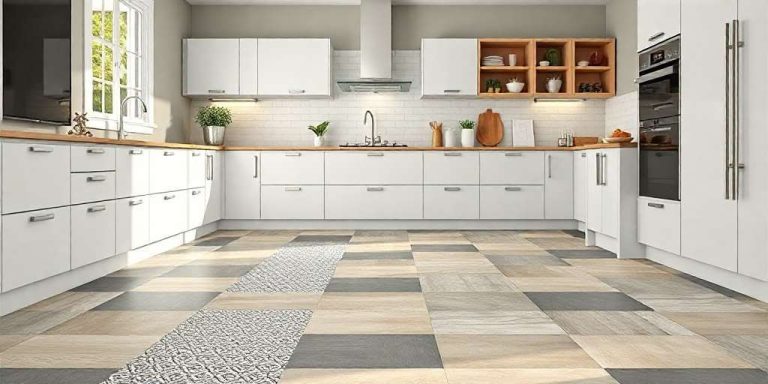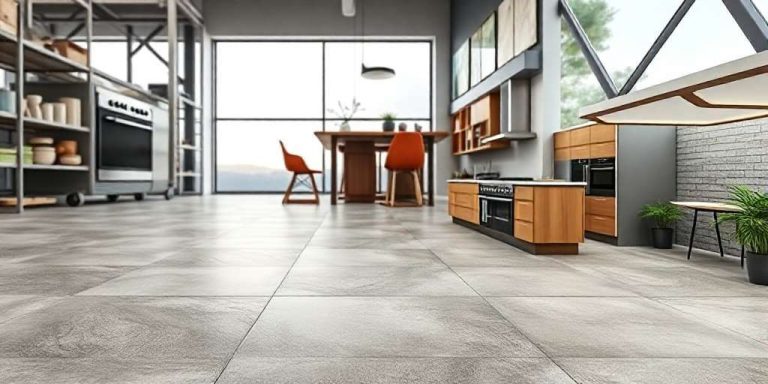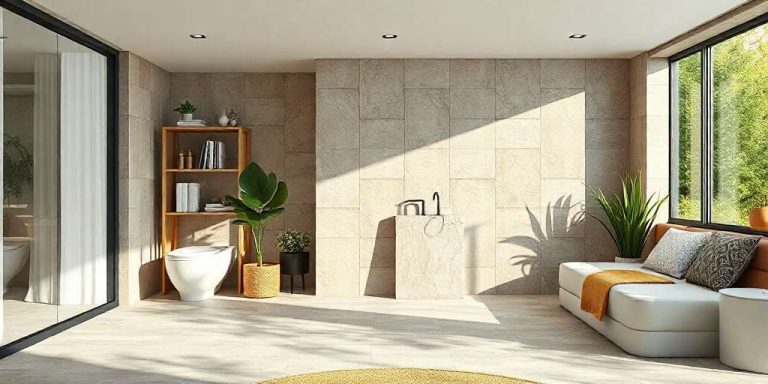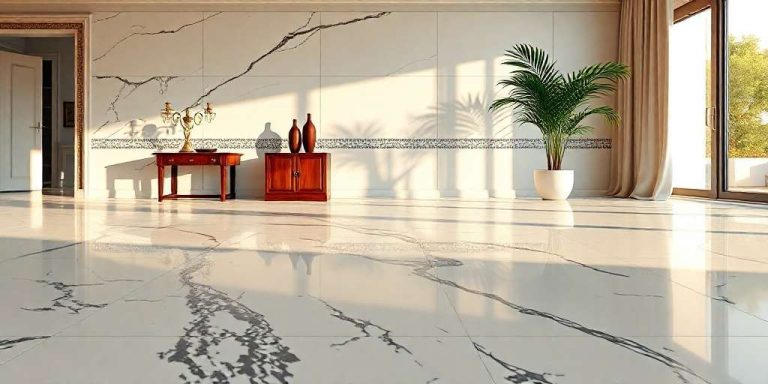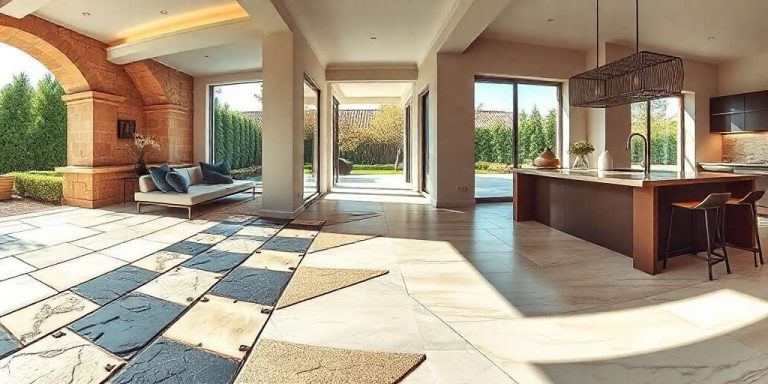Bathroom Floor Tiles: Choosing the Perfect Style and Material
Bathroom floor tiles play a critical role in both functionality and aesthetics. They must be durable, water-resistant, and easy to clean while complementing the overall design of the space. There are various types of bathroom floor tiles available, each offering unique benefits. Understanding the options can help in creating an attractive and practical bathroom environment.
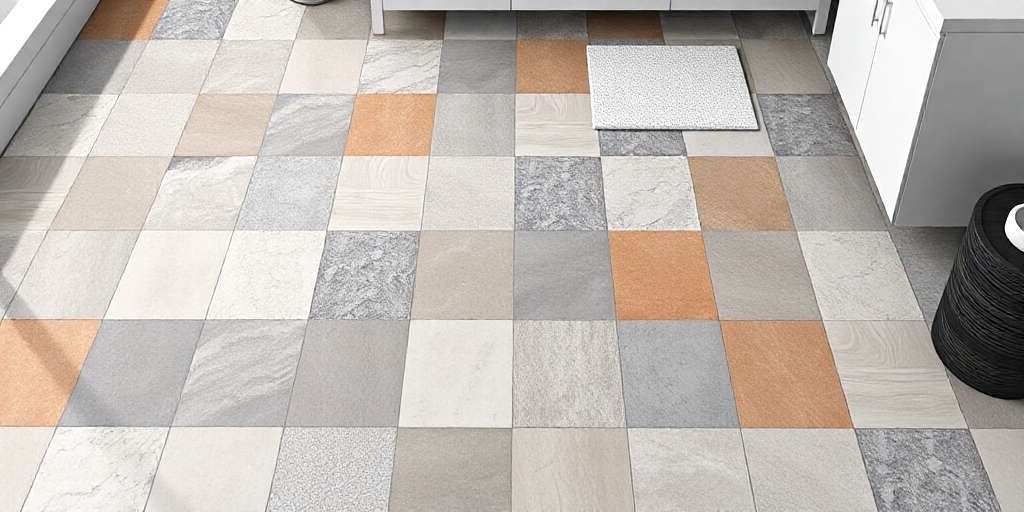
Types of Bathroom Floor Tiles
When it comes to selecting the appropriate flooring for a bathroom, various options are available, each offering unique advantages and aesthetics. The choice of material can influence both functionality and the overall design of the space.
Ceramic Tiles
Ceramic tiles are among the most popular choices for bathroom floors, primarily due to their versatility and affordability. They are made from natural clay, which is fired at high temperatures, making them resistant to moisture. The variety of designs available allows for the creation of different looks, from classic to contemporary.
- Variety of Patterns: These tiles can mimic materials like wood and stone, providing an elegant appearance without the associated maintenance.
- Cost Efficiency: Perfect for those working on a budget, ceramic tiles deliver quality without breaking the bank.
- Easy Maintenance: A non-porous surface makes cleaning simple and straightforward.
Porcelain Tiles
A step up from regular ceramic, porcelain tiles are denser and less porous. This increased durability makes them resistant to scratches and stains, suitable for high-traffic areas.
- Exceptional Strength: They hold up well in extreme temperature changes, minimizing the risk of cracks.
- Realistic Looks: Many porcelain tiles are designed to imitate natural materials, giving a luxurious feel.
- Low Water Absorption: Their low porosity helps in preventing mold growth, making them an ideal choice for bathrooms.
Natural Stone Tiles
Naturally beautiful, stone tiles such as marble, slate, and travertine bring an authentic touch to any bathroom. Each stone tile has its unique characteristics, which means no two tiles are the same.
- Luxurious Aesthetics: Stone can create a stunning visual impact, perfect for those looking to make a statement.
- Longevity: When properly sealed, stone tiles can last for decades.
- Customizable Options: Available in various shapes and finishes, allowing for personalized designs.
Vinyl Tiles
Vinyl tiles have gained traction, mainly due to their simplicity of installation and the extensive design options available. They are a great solution for busy families, providing a soft and warm feel underfoot.
- Water Resistance: Naturally resistant to moisture, vinyl tiles fit perfectly in humid environments.
- Affordable Variety: Available in numerous styles and colors, including options that resemble more premium materials.
- Comfortable Underfoot: Their softer surface makes standing for long periods more enjoyable than harder materials.
Cement Tiles
Cement tiles are recognized for their artistic and vibrant patterns. They can introduce an industrial chic look to contemporary spaces, showcasing bold designs that attract attention.
- Unique Aesthetic: The patterns available can significantly enhance the visual appeal of any bathroom.
- Durability: Cement tiles resist wear and tear, making them suitable for high-traffic areas.
- Customization: They can be crafted to fit personal styles, adding an exclusive element to the décor.
Selecting the Right Floor Tiles for Your Bathroom
Choosing the perfect tiles for a bathroom floor involves several critical factors that affect both the aesthetic appeal and functionality of the space. Different tile materials offer varying benefits, each contributing uniquely to the overall bathroom experience.
Water Resistance and Durability
Water resistance is a vital characteristic to consider when selecting tiles. Tiles should effectively withstand moisture to prevent damage and mold growth. Options like porcelain and ceramic tiles have a low porosity, making them suitable choices for humid environments. On the other hand, natural stone tiles, while beautiful, can require extra maintenance due to their inherent porosity.
Safety Features
Slip resistance is another crucial aspect in bathroom safety. Smooth tiles can become slippery when wet, creating hazards for everyone who uses the bathroom. Textured tiles or those rated for slip resistance provide safer alternatives, especially for family bathrooms where children and elderly individuals may be present.
Style and Aesthetic
Style preferences should play a significant role in the selection process. From modern minimalist designs to classic patterns, tiles can enhance the overall theme of the bathroom. Color palettes, patterns, and layouts offer endless possibilities to express personal style. Incorporating bold colors or intricate designs can transform a bathroom into a stylish retreat.
Size and Layout Considerations
The size and format of the tiles can greatly impact the perception of space within a bathroom. Larger tiles tend to create a more open feel, making small bathrooms appear more spacious. Conversely, smaller tiles or mosaics can introduce detail and character, especially in accent areas such as shower niches or borders.
Budgetary Constraints
Budget plays a pivotal role in the selection of bathroom tiles. It is essential to balance quality with affordability. High-end materials may offer superior durability and aesthetics but exploring mid-range options can also yield satisfactory results without compromising on style. Setting a clear budget upfront helps streamline choices and avoids overspending.
Maintenance Requirements
Maintenance is an often-overlooked aspect when selecting bathroom floor tiles. Some materials require regular sealing or specific cleaning products, adding long-term care costs. Tiles that are easy to clean and maintain may reduce overall effort and expense in keeping the bathroom fresh and inviting.
Consulting Professionals
For those who may feel overwhelmed by the available options, consulting with design professionals can provide tailored advice. Experts can assist in identifying the best materials suited for individual needs while considering style, budget, and functionality. Their insights can lead to a more informed and satisfying tile selection process.
Installation Tips for Bathroom Floor Tiles
Efficient installation is crucial for achieving a long-lasting and visually appealing bathroom floor. Proper techniques ensure that tiles remain intact and maintain their aesthetic charm over time. Preparation before beginning the installation process is a key factor that determines the success of the project.
Initial steps involve assessing the subfloor. The surface must be clean, dry, and level to create a strong foundation for the tiles. Any imperfections, such as cracks or bumps, should be addressed beforehand. A leveling compound may be used for uneven surfaces, while patching materials can fill in cracks. Once the subfloor is ready, the next step is to gather all necessary materials and tools.
- Tile of choice (ceramic, porcelain, etc.)
- Thin-set mortar
- Notched trowel
- Tile spacers
- Tile cutter or wet saw
- Grout
- Sponge and bucket for cleaning
- Sealant (for natural stone tiles)
Following preparation, measuring the area to be tiled is essential. This involves marking reference lines to guide tile placement. Starting from the center of the room or a predetermined focal point can provide a balanced look. Spreading the thin-set mortar using a notched trowel allows for optimal adhesion between the tiles and the subfloor.
The placement of the tiles begins with the first tile being pressed firmly into the mortar, followed by inserting tile spacers. These spacers facilitate uniform gaps for grout application later on. Subsequent tiles are added in a staggered pattern, which enhances the overall aesthetic and structural stability. Engaging a helper may expedite the process, especially in larger areas.
Cutting tiles may be necessary to fit edges and corners. A tile cutter or wet saw can assist in achieving clean cuts. It’s important to measure twice and cut once to ensure accuracy and minimize waste. After all tiles are laid, it’s essential to allow the mortar to set as per manufacturer instructions before proceeding with grout application.
Once the mortar has adequately cured, grout is applied to the spaces between the tiles. This process involves using a rubber float to push grout into the joints effectively. Excess grout should be wiped away using a damp sponge, ensuring that the surface of the tiles remains clean. After the grout has dried, sealing it can help protect against moisture and stains, particularly in natural stone applications.
Properly installed bathroom floor tiles provide not only aesthetic appeal but also long-term durability. By following structured installation practices, homeowners can create a beautiful and resilient foundation for their bathrooms.
Maintaining and Cleaning Bathroom Floor Tiles
Regular maintenance is paramount to preserving the beauty and functionality of bathroom floor tiles. Different tile materials require specific cleaning techniques to ensure longevity and minimize wear. It is essential to adopt a routine that prevents buildup and maintains aesthetics.
Routine Cleaning
Cleansing the tiles on a consistent basis keeps dirt and grime at bay. The following steps can be included in a regular cleaning schedule:
- Sweep or vacuum the floor to remove loose dirt and debris, focusing on corners and grout lines.
- Mop the tiles using a damp mop and a mild detergent. Avoid harsh chemicals that can damage the tile finish.
- For stubborn stains, a mixture of baking soda and water can be effective when gently scrubbed.
Dealing with Stains
Handling spills and stains promptly can prevent long-term damage. Different types of tiles might require unique approaches:
- Porcelain and ceramic tiles are generally resistant but still need immediate cleaning for harmful substances.
- Natural stone tiles may absorb liquids quickly, making it critical to blot the spill rather than wiping it.
Grout Care
The grout between tiles often collects grime more readily than the tiles themselves. To maintain the integrity and appearance of grout:
- Use a specialized grout cleaner to break down dirt and stains.
- Consider sealing the grout lines to guard against moisture and staining agents.
Long-Term Maintenance
Periodic deep cleaning is advisable for maintaining the overall condition of the tiles. This can be achieved through:
- Employing steam cleaners to provide a deep clean without harsh chemicals, ideal for both tiles and grout.
- Scheduling a professional cleaning service once or twice a year, especially for natural stone tiles that require expert care.
Attention to maintenance and cleaning not only preserves the aesthetics of bathroom floor tiles but also enhances safety and hygiene. Ensuring surfaces are kept clean and free from moisture builds a healthier environment, preventing mold and mildew growth.
Implementing a consistent routine and using appropriate products tailored to the type of tile will keep flooring looking pristine and functional for many years to come. Taking these steps ensures that each tile’s unique properties are honored while maintaining a stylish bathroom space.
Latest Trends in Bathroom Floor Tile Designs
Current trends in bathroom floor tile designs reflect a blend of functionality and artistic expression. Homeowners are increasingly drawn to options that not only serve practical purposes but also elevate the overall aesthetics of their bathrooms. As personal styles evolve, so do tile options, which now feature more innovative designs, materials, and colors.
- Natural Aesthetics: Tiles that mimic natural materials have become a favorite. This includes ceramic and porcelain tiles designed to resemble wood, stone, or marble. The allure of organic textures brings an earthy feel to bathrooms, creating a serene, spa-like atmosphere.
- Neutral Color Palettes: Soft, muted tones dominate modern bathroom designs. Shades of gray, beige, and soft whites are popular for their calming presence. These colors offer versatility and can be paired with vibrant accessories or fixtures, allowing for easy updates in the future.
- Textured Surfaces: Safety is a top priority in bathroom spaces. Textured tiles that provide a non-slip surface are gaining popularity. Beyond safety, these tiles create visual interest and depth, making them an excellent option for contemporary designs.
- Bold Geometric Patterns: Geometric patterns are making waves in the bathroom design landscape. Unique shapes and dynamic tile layouts are becoming common, allowing homeowners to express their creativity boldly. These designs can transform a simple bathroom into a striking visual centerpiece.
- Large Format Tiles: Oversized tiles are favored for their ability to create a seamless look with fewer grout lines. This design choice not only enhances the sense of space but also simplifies maintenance, making cleaning less of a chore.
- Eco-Friendly Materials: Sustainability is becoming a significant consideration in tile selection. Eco-friendly options made from recycled materials or with low environmental impact are highly appealing to environmentally conscious homeowners. These tiles offer a stylish choice without compromising on ecological values.
Unique combinations of tiles are also trending, where various styles and patterns are mixed within the same space to create custom designs. This layering effect can enhance the character of a bathroom, allowing for personalized flair that stands out.
The evolution in bathroom floor tile design continues to reflect shifts in interior trends and consumer preferences. As styles adapt, the focus remains on achieving a balance between beauty and practicality, ensuring that bathrooms are not only visually striking but also functional and safe.
Budgeting for Bathroom Floor Tiles
Determining a budget for bathroom floor tiles involves several key considerations to ensure a successful project without overspending. Establishing a clear financial plan makes the selection process smoother and helps prioritize essential features without compromising on quality.
One of the primary factors influencing the budget is the type of tile chosen. Prices can vary significantly based on material, aesthetic appeal, and durability. For example, ceramic tiles are usually more affordable than natural stone, making them a practical choice for homeowners on a tighter budget. Conversely, high-end porcelain or luxury natural stone tiles represent a greater investment.
Installation costs are another crucial element of the overall budget. Hiring a professional installer adds to the expense but can save time and ensure quality workmanship. DIY enthusiasts may reduce labor costs but should consider whether they possess the necessary skills and tools for a successful installation. Costs associated with installation may include:
- Labor fees for professional tile installers
- Materials for underlayment or backer board
- Grout, adhesive, and sealing products
Taking into account the size of the bathroom is vital when calculating costs. Larger areas will inevitably require more tiles and materials, leading to higher expenses. Accurate measurements of the space can help avoid shortfalls or oversupply, both of which can disrupt budgeting.
While planning, it is essential to include the ongoing maintenance costs associated with various tile types. Some materials may need more frequent sealing or specialized cleaning products. This aspect can influence the choice of tiles based on long-term expenditures.
Lastly, setting aside a contingency fund for unexpected expenses is always wise. Renovations often come with unforeseen issues, such as water damage or structural repairs, that can quickly derail the original budget. A well-prepared financial plan allows for a smoother renovation experience without financial strain.


